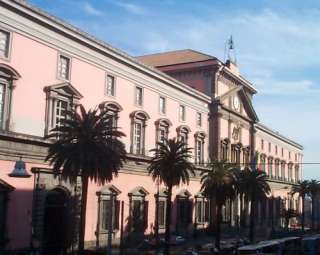|
|
| |
ITALY
NAPLES MUSEUMS
Naples National Archaeological Museum The Naples National Archaeological Museum is located in Naples, at the northwest corner of the original Greek wall of the city of Neapolis. The museum contains a large collection of Roman artifacts from Pompeii, Stabiae and Herculaneum. The collection includes works of the highest quality produced in Greek, Roman and Renaissance times. It is widely regarded as the most important Italian archaeological museum.
The museum hosts extensive collections of Greek and Roman antiquities. Their core is from the Farnese Collection, which includes a collection of engraved gems (including the Farnese Cup, a Ptolemaic bowl made of sardonyx agate and the most famous piece in the "Treasure of the Magnificent", and is founded upon gems collected by Cosimo de' Medici and Lorenzo il Magnifico in the 15th century) and the Farnese Marbles.
The museum also has the third largest collection of Egyptian artifacts in Italy, after the Vatican Museum and the Museo Egizio in Turin. It is made up primarily of works from two private collections, assembled by Cardinal Borgia in the second half of the 18th century, and Picchianti in the first years of the 19th. the collection provides both an important record of Egyptian civilization from the Old Kingdom (2700-2200 B.C.) up to the Ptolemaic-Roman era.
For more information regarding the museum please contact National Archaeological Museum
Piazza Museo Nazionale 19, 80135, Naples
Tel: +39 081 44 0166, E-mail: archeona@arti.beniculturali.it
 Naples National Archaeological Museum
Palace of Caserta The Royal Palace of Caserta is a former royal residence in Caserta, southern Italy, constructed for the Bourbon kings of Naples. It was the largest palace and one of the largest buildings erected in Europe during the eighteenth century. In 1997, the Palace was designated a UNESCO World Heritage Site, described in its nomination as "the swan song of the spectacular art of the Baroque, from which it adopted all the features needed to create the illusions of multidirectional space". The palace has some 1,200 rooms, including two dozen state apartments, a large library, and a theatre modelled after the Teatro San Carlo of Naples.
The garden, a typical example of the baroque extension of formal vistas. It is inspired by the park of Versailles, but it is commonly regarded as superior in beauty. The park starts from the back fašade of the palace, flanking a long alley with artificial fountains and cascades. There is an English garden in the upper part designed in the 1780s by Carlo Vanvitelli and the London-trained plantsman-designer John Graefer. The park includes:
The Fountain of Diana and Actaeon (sculptures by Paolo Persico, Brunelli, Pietro Solari)
The Fountain of Venus and Adonis (1770-80)
The Fountain of the Dolphins (1773-80)
The Fountain of Aeolus
The Fountain of Ceres
For more information and enquiries please contact Palazzo Reale
Viale Douhet,
I-81100 Caserta,
Italy, Tel: 0823 448084/ 0823 277380, E-mail: reggiacaserta@tin.it / caserta@arethusa.it
 The Actaeon sculptural group at the Cascade Photo taken by psub National Museum of CapodimonteThe National Museum of Capodimonte is located in the Palace of Capodimonte, a grand Bourbon palazzo in Naples, Italy. The museum is the prime repository of Neapolitan painting and decorative art, with several important works from other Italian schools of painting, and some important Ancient Roman sculptures.
The first and second floors house the Galleria Nazionale (National Gallery), with paintings from the 13th to the 18th centuries including major works by Simone Martini, Raphael, Titian, Caravaggio, El Greco and many others. The museum is by far the best place to see paintings of the Neapolitan School, often under-appreciated by the wider world, with large holdings of Jusepe de Ribera, Luca Giordano, the Neapolitan Caravaggisti and many others. Much of the ground floor is taken up by part of the magnificent Farnese collection of classical, mostly Roman, monumental sculpture, which survives here and in the Naples National Archaeological Museum largely intact. Elsewhere in the palace the royal apartments are furnished with antique 18th-century furniture and a collection of porcelain and majolica from the various royal residences
For more information and enquiries please contact Museo Nazionale di Capodimonte, 1 via Miano, Parco di Capodimonte 80131, Tel: 848 800 288 or +39 06 39967050 , E-mail: artina@arti.beniculturali.it
Pietrarsa Railway MuseumThe Pietrarsa railway museum is situated in San Giorgio a Cremano. It lies south of Naples in southern Italy just to the side of the Naples–Portici railway line, the first one in Italy. It is served by the Pietrarsa-S.Giorgio a Cremano station to which it is connected by a pedestrian subway. The museum contains original engines as well as scale models incorporated into a display of the history of trains in Italy. The displays include a copy of Bayard, the first locomotive in Italy, which started its run on the Naples–Portici railway line on 3 October 1838. The museum opened in 1989, underwent an intensive restoration in 2006 and reopened on 19 December 2007.
 Main exhibition hall to the Pietrarsa railway museum. Photo taken by Reinhard Dietrich.
|
|
|
|
|